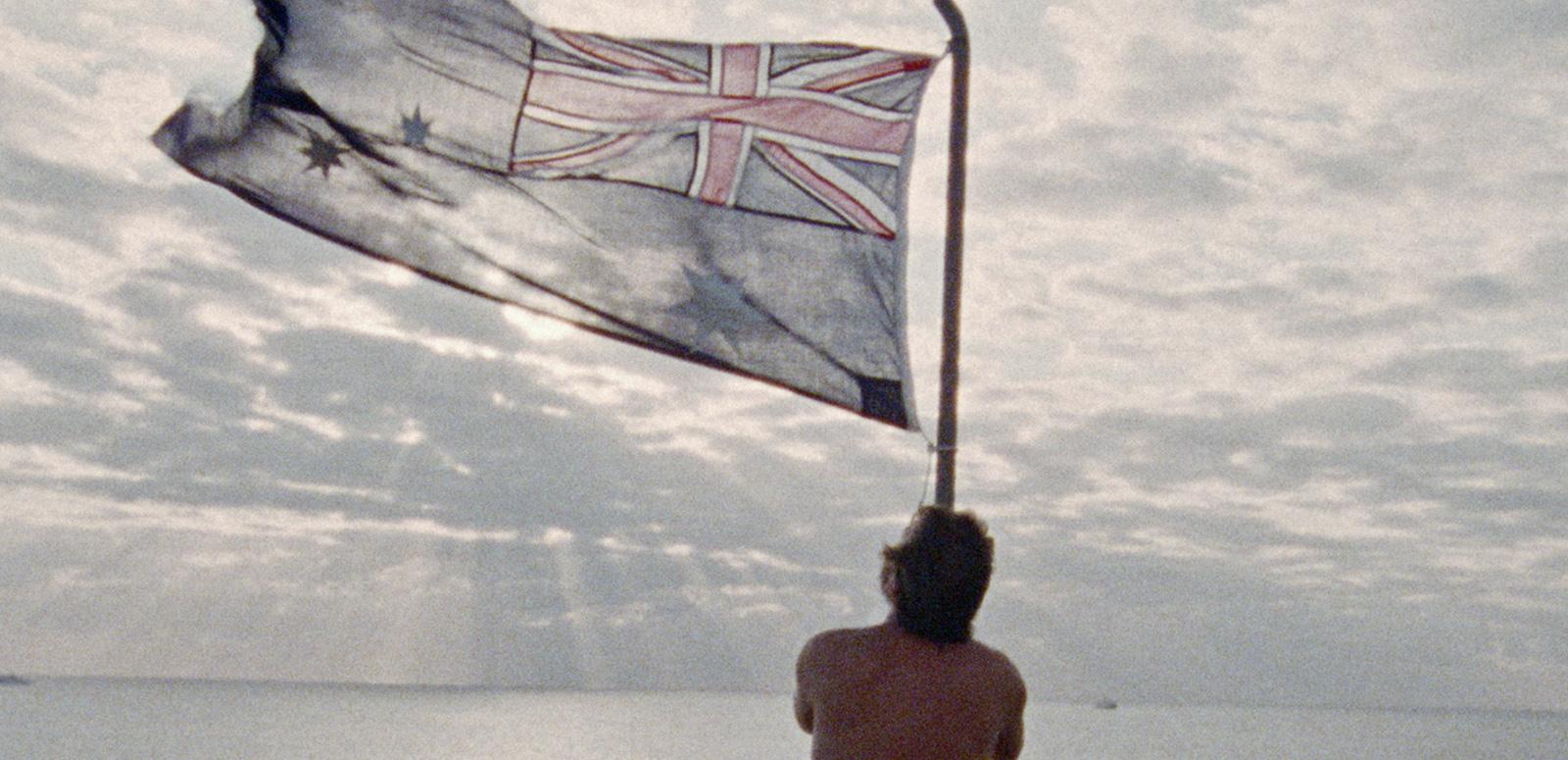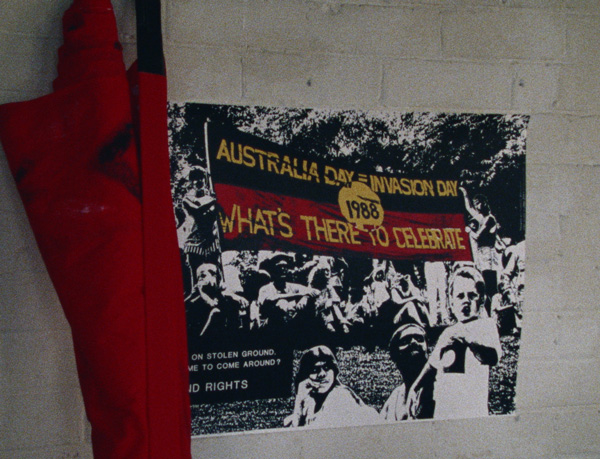Sean Bridgeman looks back at the documentary Australia Daze (1988), newly restored as part of the NFSA Restores program.
WARNING: this article may contain names, images or voices of deceased Aboriginal and Torres Strait Islander people.

Sean Bridgeman looks back at the documentary Australia Daze (1988), newly restored as part of the NFSA Restores program.
WARNING: this article may contain names, images or voices of deceased Aboriginal and Torres Strait Islander people.
From midnight to midnight on 26 January 1988, the day Australia marked 200 years of European settlement, 28 film crews spread out across the country to ask people for their reflections on the bicentenary, contemporary Australia and our history.
The questions people were asked included: What does the bicentenary mean? Is it worth celebrating? Can you understand why Aboriginal Australians and others might feel differently about this day? Is multiculturalism working and is our treatment of migrants fair? What is good or bad about Australia and what, if anything, needs to change? Where are we heading?
What we witness in response is an array of patriotism, protest, indifference – and sheer relief it's a public holiday.
What makes Australia Daze worth revisiting 33 years later is the context and timing of its filming. On 26 January 1988, Australia was in the middle of an economic boom – characterised by soaring asset prices and the emergence of a ‘yuppie’ class (who feature prominently in the film). It was three years before the devastating 1991 recession – the hangover ‘we had to have’ from the good times of the late 1980s.
Australia Daze conscientiously involves people of all ages across the spectrum of socio-economic life in Australia – from Sydney's harbourside-dwelling 'elites' to miners working in rural Queensland, homeless people and those living below the poverty line, the broad swathe of suburban and inner-city middle class, retirees, migrants and their children, prominent Aboriginal Australians, media personalities and politicians.
In this clip, different generations of migrants share their views on being Australian:
Excerpt from documentary Australia Daze (Pat Fiske, 1988). NFSA title: 43660.
While the various segment directors sought to squeeze in all these subjects, each of which could be their own film, the real focus of Australia Daze was the dual events taking place in Sydney – the official bicentennial celebrations on and around the harbour and the Aboriginal march from Redfern to Hyde Park. These two events represented the current and future challenge for Aboriginal and non-Aboriginal relations – and for all of Australia to reconcile its Aboriginal and European histories.
In the context of relations between Aboriginal and non-Aboriginal Australians in 1988, Australia Daze vitally captures a broad sweep of Australian attitudes on the eve of the many great legal and symbolic events of the 1990s. In this clip, we hear from Linda Burney – who in 2016 became the first Aboriginal woman to be elected to the Australian House of Representatives – and see footage of Aboriginal protests in Sydney:
Excerpt from documentary Australia Daze (Pat Fiske, 1988). NFSA title: 43660.
Through Australia Daze we see an Australia 3 years before the Report of the Royal Commission into Aboriginal Deaths in Custody, the ‘Redfern Speech’ delivered by Paul Keating and the establishment of the Council for Aboriginal Reconciliation; 4 years before the Mabo decision of the High Court and the doctrine of native title, followed by the Native Title Act 1993; 7 years before the High Court’s Wik Decision; 8 years before the Human Rights and Equal Opportunity Commission’s Stolen Generations report Bringing Them Home, eventually followed by the 'National Apology to the Stolen Generations' in 2008; and 12 years before 250,000 Australians crossed the Sydney Harbour Bridge as part of the Walk for Reconciliation in 2000.
Over dinner one night, Pat Fiske, Dennis O’Rourke and other filmmakers devised Australia Daze as a response to the official build-up to the bicentennial events – regarded by them as a one-dimensional celebration absent of historical reflection or a desire for reconciliation.
The logistics involved in shooting the film were impressive. There were 28 film crews scattered across Australia under the supervision of overall director Pat Fiske. They shot on 16mm, with additional footage supplied by the ABC and commercial news footage.
Other filmmakers contributed super 8mm and video material, and the filmmakers also collected hours of radio talkback. It took 12 hours a day for a whole week simply to view the unedited material and 9 months for 2 editors to cut the film.

The experience was exhausting and very depressing, but the underlying humanity and humour heartened us.
Viewing Australia Daze for the first time now is to cringe at the brick veneer of late 1980s Australiana – it's hilarious and horrifying. But 33 years later, on Australia Day 2021, the issues explored by Australia Daze remain as relevant today as they were in 1988.
While there have been some gains in mainstream recognition of Australia’s Aboriginal and Torres Strait Islander history and cultures, and steps toward reconciliation, Australians continue to ask ourselves and our governments 'what fundamentally has changed?'.
The film presages the rise of the culture and 'history wars' of the 1990s that continue today – think of the fights over statues of Cook and other Europeans, or the funding of certain events to commemorate 250 years since Cook’s Endeavour sailed up the East Coast of Australia.
Excerpt from documentary Australia Daze (Pat Fiske, 1988). NFSA title: 43660.
Each year people contest the appropriateness of 26 January being commemorated as Australia’s national day. Perhaps part of the film's value is that it prompts debate and reflection on our history.
It’s interesting to note the campaign for this year frames Australia Day as beginning ‘... 60,000 years ago... [W]e reflect on our history, its highs and its lows... We respect the stories of others... We're all part of the story.’ It makes you wonder if Australia Daze was made again today, how would it differ from the original?
NFSA Restores: Australia Daze screened around Australia on 26 and 27 January 2021.
Want to be the first to hear stories and news from the NFSA?
Subscribe to our newsletter and never miss out.
The National Film and Sound Archive of Australia acknowledges Australia’s Aboriginal and Torres Strait Islander peoples as the Traditional Custodians of the land on which we work and live and gives respect to their Elders both past and present.